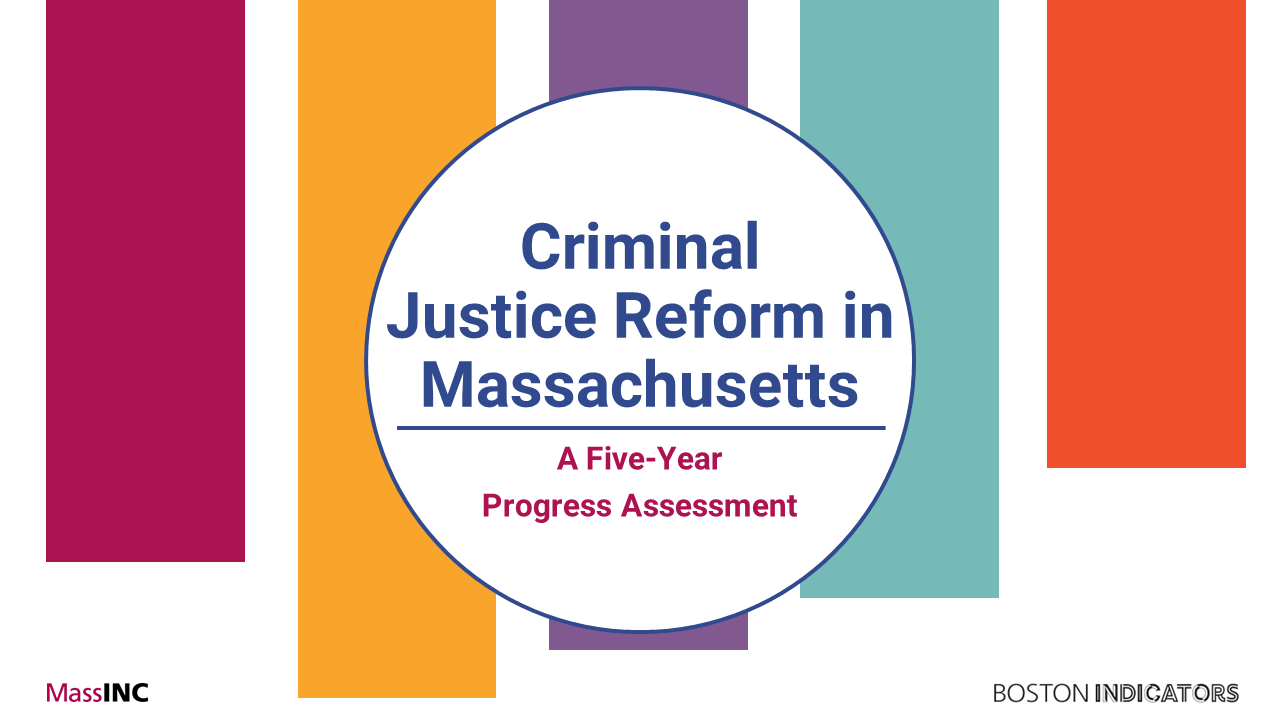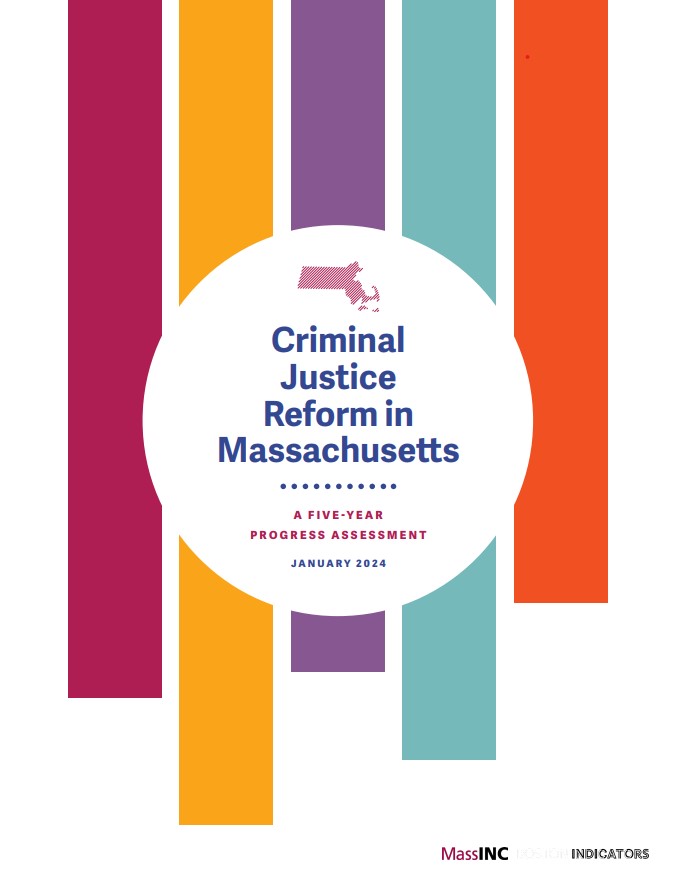Criminal Justice Reform in Massachusetts: A Five-Year Progress Assessement Release
January 24, 2024
The opening speakers at the Boston Foundation’s January 24 forum remembered two great champions of criminal justice reform, both of whom had worked closely with TBF over the years. Jim Rooney (1967–2023) and Greg Torres (1949–2023) had been ardent and persistent in their push to make the criminal justice system in the Commonwealth more equitable and rational. The audience gathered for the release of Criminal Justice Reform in Massachusetts: A Five-year Progress Assessment was full of people carrying on and expanding their work, with the same clear dedication and passion.
TBF Vice President of Communications and Public Affairs Keith Mahoney welcomed the combined in-person and online attendees, noting the Boston Foundation’s long-sustained work in the space. Just this century TBF has with various partners sought to collect and assess data on, and advocate for change in areas such as Criminal Offender Record Information (CORI) systems, probation issues, spending on support of returning citizens, and educational and workforce training opportunities to people while incarcerated, to name a few.
Some of these efforts helped drive the 2018 criminal justice reform legislation that the just-released report assesses. MassINC and Boston Indicators collaborated on the publication. MassINC Research Director Ben Forman foregrounded the data presentations and set forth the questions the report sought answers to:
- Did reforms lead to meaningful reductions in incarceration?
- Did they reduce racial disparities?
- Has Massachusetts made meaningful investments in alternatives to incarceration?
- Is the “less incarceration = more public safety” formula working?
Co-authors Elise Rapoza, Senior Research Associate at MassINC, and Boston Indicators Senior Research Analyst Peter Ciurzcak presented findings on crime rates, incarceration rates, investment trends, and obstacles to improvements in treatment, rehabilitation, and community economic development. In short, Massachusetts has one of the lowest crime rates and lowest incarceration rates in the country, despite blips in the last year, those have trended lower since the 2018 legislation. A closer look, however, reveals that the reduction in crime and increase in diversion from imprisonment has not been equal across populations. A particularly striking statistic was the percent change in pretrial detention. Overall, it was down 20 percent. Scrutinized by race, however, it was down 41 percent for the White population, down 3 percent for the Black population, and up 37 percent for the Latino population. Clearly this needs further attention. As does the situation around the capacity of alternatives to prison. The state has only 660 mental health inpatient facility beds for adults, and 30 for emerging adults.
The presentation and report recommendations were discussed by a panel of experts steeped in knowledge of the system from multiple angles.
Moderator Jenifer McKim guided a conversation around what elements of the report stood out, and what concerns rose to the top for each panelist. There was much overlap: The improvements following removal of mandatory minimum sentences on low-level crimes and the expansion, if modest, of restorative justice practices were welcomed by all. The findings on racial disparities—while perhaps not surprising—were striking in their clarity. Arnie Lucinda Stewart from the Public Defender Division, who’d also been a D.C. police officer early in her career, spoke for all in saying, “We’ve got to look at root causes for the disparities and be prepared to have an action plan to deal with those causes.” That means the causes within the criminal justice system and those that foster inequities for people before they tumble into the system.
UTEC CEO Greg Croteau agreed, and pointed to the high potential for good outcomes in focusing on emerging adults. His organization tries especially “to work with the 10 percent who are involved in 90 percent of the action on the street.” Investment in reentry preparation for 18–25-year-olds, Croteau believes, offers the highest returns in terms of reducing recidivism. His UTEC colleague Paul Chaleunphong sharpened this point by sharing his recent work with a client due to be released in two weeks. The client was intensely anxious about where he would go and what he would do upon release. Not every returning citizen is able to access a UTEC-type support program, and many people are released straight from maximum security to the outside.
Probation Commissioner Pamerson Ifill shared his office’s appreciation for the organizations like UTEC that support people leaving incarceration. “The lifeblood and strength of Probation is to collaborate and leverage community resources,” he said. And he amplified Attorney Stewart’s call for a deeper look behind the data. “The kind of data we had in 2018 wasn’t enough. We ‘ve been trying to build new systems to understand more than supervision, but also outcomes data.”
Removing mandatory minimum sentencing on the front end and increasing transitional housing and employment support on the back end of the criminal justice process appear to be promising moves for improving outcomes. As comments and questions from the audience suggested, the middle of the process also needs investment and attention. Chaleunphong affirmed this in moving statements about his own experience. “When the 2018 reform bill passed,” he said, “I was just walking out of [MCI] Norfolk.” He appreciated the advocates and lawmakers in the room who had pushed for the reform. But above all, he remembered the advice of a “lifer” who urged him to take advantage of rehabilitative programming when he was transferred from a maximum security facility to Norfolk. “Being in a supermax like Souza with no way to get home is heartbreaking,” he said. “It’s dehumanizing and chaotic because of a lack of resources. But programming can build up inmates’ self-esteem and value, and they can help others.”
Agenda
Welcome & Opening Remarks
Keith Mahoney, Vice President, Communications & Public Affairs, The Boston Foundation
Presentation of Report
Peter Ciurczak, Senior Research Analyst, Boston Indicators
Ben Forman, Research Director, MassINC
Elise Rapoza, Senior Research Associate, MassINC
Panel Discussion and Q&A
Viengsamay “Paul” Chaleunphong, Re-Entry Manager, UTEC
Gregg Croteau, Chief Executive Officer, UTEC
Pamerson Ifill, Commissioner of Probation, Massachusetts Probation Service
Jenifer B. McKim, Deputy Investigative Editor, GBH (Moderator)
Arnie Stewart, Deputy Chief Counsel, Public Defender Division, Committee for Public Counsel Services (CPCS)


